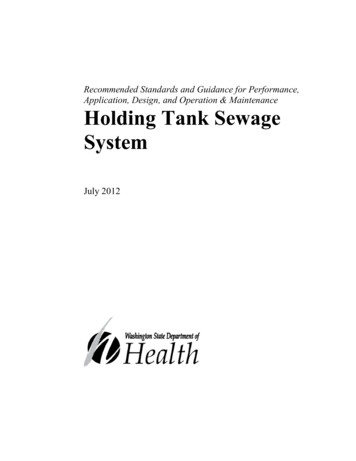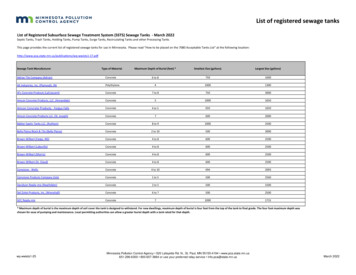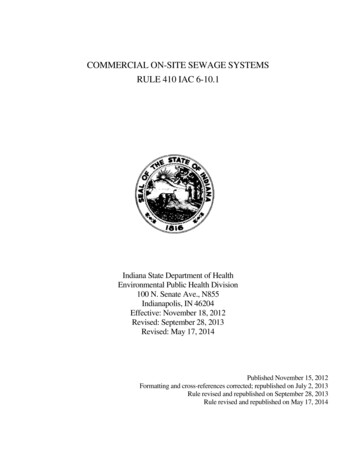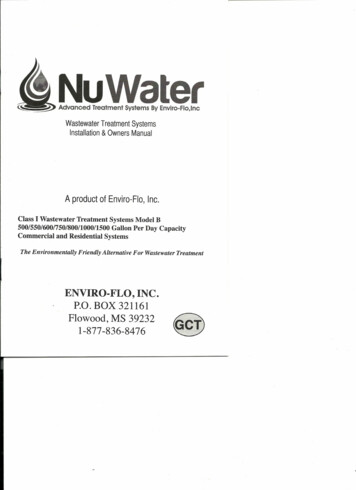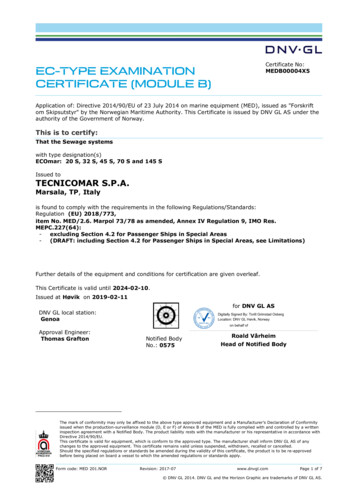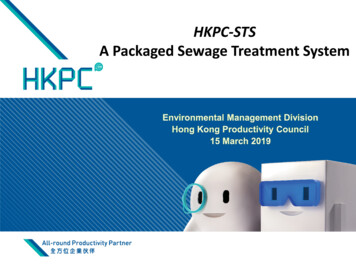
Transcription
Characterization of sewage and design of sewagetreatment plantA THESIS SUBMITTED IN PARTIAL FULFILLMENTOF THE REQUIREMENT FOR THE DEGREE OFBachelor of Technology in Civil EngineeringByFALGUNI K.P. MISHRA, 108CE001NILADRI BIHARI MAHANTY, 108CE020Department of Civil EngineeringNational Institute of Technology, Rourkela2012
Characterization of sewage and design of sewagetreatment plantA THESIS SUBMITTED IN PARTIAL FULFILLMENTOF THE REQUIREMENT FOR THE DEGREE OFBachelor of Technology in Civil EngineeringByFALGUNI K.P. MISHRANILADRI BIHARI MAHANTYUnder supervision ofProf. Kakoli Karar PaulDepartment of Civil EngineeringNational Institute of Technology, Rourkela2012
National Institute of TechnologyRourkelaCERTIFICATEThis is to certify that the thesis entitled “Characterization of sewage anddesign of sewage treatment plant” submitted by Falguni Krishna PrasadMishra, Roll No. 108CE001 and Niladri Bihari Mahanty, Roll No.108CE020 in partial fulfillment of the requirements for the award ofBachelor of Technology degree in Civil Engineering at the NationalInstitute of Technology, Rourkela is an authentic work carried out bythem under my supervision and guidance.To the best of my knowledge, the matter embodied in the thesis has notbeen submitted to any other University/Institute for the award of anyDegree or Diploma.Date:(Prof. KAKOLI K. PAUL)
ACKNOWLEDGEMENTMy heart quivers with the thrill for offering gratitude to those individualswho helped me in completion of the project. The most idyllic point ofpresenting a thesis is the opportunity to thank those who have contributedto it.Unfortunately, the list of acknowledging no matter how extensive isalways incomplete and inadequate. Indeed this page of mention shall neverbe able to touch the horizon of generousness of those who tendered theirhelp to me. First of all, I would like to express my gratitude and obligationsto Prof Kakoli K. Paul, for her kindness in allowing me for introducing thepresent topic and for her inspiring direction, constructive judgment andvaluable propositions throughout this project work. Next, I would like tothank Mr. N. Chaitanya Kavuri, a Ph. D. scholar for his relentless helpwithout any complain. I am sincerely thankful to him for his effort inimproving my contents of this project.I am also thankful to Prof. N. Roy (Head of the Department) for assigningme this interesting project and for his valuable suggestions and boosts atvarious stages of the work. A combination of this nature could never havebeen attempted without reference to and inspiration from the works ofothers whose details are mentioned in reference section. I acknowledge myindebtedness to all of them.Last but not least, my sincere thanks to all my friends who have patientlyextended all sorts of help for achieving this undertaking.FALGUNI KRISHNA PRASAD MISHRA108CE001NILADRI BIHARI MAHANTY108CE020Dept. of Civil engineeringNational Institute of TechnologyRourkela – 769008
CONTENTSPAGEList of figures and tablesAbstract1.2.3.4.iiiINTRODUCTION1.1 Introduction1.2 Objectives of the study1.3 Literature Review234MONITORING PROTOCOLS2.1 Study Area2.2 Sampling Techniques88ANALYSIS TECHNIQUES3.01 Methodology for measurement of pH value3.02 Methodology for measurement of Alkalinity3.03 Methodology for measurement of Turbidity3.04 Methodology for measurement of Acidity3.05 Methodology for measurement of Chloride3.06 Methodology for measurement of Residual Chlorine3.07 Methodology for measurement of Total Solids3.08 Methodology for measurement of DO3.09 Methodology for measurement of BOD3.10 Methodology for measurement of hardness3.11 Methodology for measurement of carbonates andbicarbonates3.12 Methodology for measurement of metalsRESULTS AND DISCUSSION4.1 Tabulations11121415171919212123252932
5.DESIGN OF SEWAGE TREATMENT PLANT396.TIMELINE OF THE PROJECT457.CONCLUSION478.REFERENCES49
iLIST OF TABLES1.2.3.4.5.PAGEWater consumption by various residential hallsof NIT Rourkela.32Water consumption by residential quarters inNIT Rourkela.33Physical and chemical characteristics of wastewater in different time.37Determination of different metal contentat different time.38Milestone of the study.46LIST OF FIGURESPAGE1. Map of Study Area92. Top view of the Sewage Treatment Plant433. Layout of the Sewage Treatment Plant44
iiABSTRACTThe National Institute of Technology Rourkela is one of the most importanteducational institutes in the state of Orissa with a large number of peopleresiding in its campus consisting of a number of laboratories of variousdepartments, residential units, academic blocks and number of hostels.A study on domestic waste water characterization has been performedfollowed by the design of sewage treatment plant. The present studyinvolves the analysis of pH value, total solids, total suspended solids,hardness, acidity, alkalinity, chloride, chlorine, BOD, DO and heavy metalssuch as Iron, Copper, Zinc, Magnesium, Nickel, Chromium, Lead, Calcium,Aluminium, Silicon, Potassium.A sewage treatment plant is quite necessary to receive the domestic andcommercial waste and removes the materials which pose harm for generalpublic. Its objective is to produce an environmentally-safe fluid wastestream (or treated effluent) and a solid waste (or treated sludge) suitablefor disposal or reuse (usually as farm fertilizer).The samplings of the domestic waste from hostels have been done indifferent times of the day to have an average data of the measuredparameters. The average values of pH, Turbidity, Acidity, Chloride,Residual Chlorine, Hardness, Total Solid, BOD, DO, Alkalinity, Total IronContent, Zinc Content, Potassium, Copper, Magnesium, Nickel,Chromium, Lead, Calcium, Aluminum and Silicon are found out.A sewage treatment plant has been designed with the treatment units, a barscreen of dimension 1.7m, an aeration tank of dimension 4.5 x 4.5 x 3.7 m3,a collection pit of diameter 4m and depth 5 m.Keywords: Characterization, sewage, treatment plant.
1CHAPTER 1INTRODUCTION
21.1Introduction:Pollution in its broadest sense includes all changes that curtail naturalutility and exert deleterious effect on life. The crisis triggered by therapidly growing population and industrialization with the resultantdegradation of the environment causes a grave threat to the quality of life.Degradation of water quality is the unfavorable alteration of the physical,chemical and biological properties of water that prevents domestic,commercial, industrial, agricultural, recreational and other beneficial usesof water. Sewage and sewage effluents are the major sources of waterpollution. Sewage is mainly composed of human fecal material, domesticwastes including wash-water and industrial wastes.The growing environmental pollution needs for decontaminating wastewater result in the study of characterization of waste water, especiallydomestic sewage. In the past, domestic waste water treatment was mainlyconfined to organic carbon removal. Recently, increasing pollution in thewaste water leads to developing and implementing new treatmenttechniques to control nitrogen and other priority pollutants.Sewage Treatment Plant is a facility designed to receive the waste fromdomestic, commercial and industrial sources and to remove materials thatdamage water quality and compromise public health and safety whendischarged into water receiving systems. It includes physical, chemical,and biological processes to remove various contaminants depending on itsconstituents. Using advanced technology it is now possible to re-usesewage effluent for drinking water.The present study comprises the study on quality of domestic waste waterthat is discharged from the HB Hall of National Institute of Technology,Rourkela, through the kitchen outlets and bathroom effluents. The studyincludes characterization tests for pH value, acidity, alkalinity, chloride,residual chlorine, turbidity & DO.
31.2Objectives of the study:The principal objective of waste water treatment is generally to allowhuman and industrial effluents to be disposed of without danger to humanhealth or unacceptable damage to the natural environment. Anenvironmentally-safe fluid waste stream is produced. No danger to humanhealth or unacceptable damage to the natural environment is expected.Sewage includes household waste liquid from toilets, baths, showers,kitchens, sinks and so forth that is disposed of via sewers. Sewage alsoincludes liquid waste from industry and commerce.The objectives of the study are:1. Physical, chemical and biological characterization of the domesticwaste water from hostels of NIT, Rourkela2. Comparison with the prescribed standard3. Design of the sewage treatment plant.Observation of Study: Waste water samples from the kitchen effluent andthe bathroom waste of Homi Bhabha Hall of Residence. The presence studyis designed to collect waste water sample from HBH. The study includesalso MSS Hall.The following physical characteristics were rbidity
4The following chemical characteristics were studied:i.ii.iii.iv.v.vi.Total IronCopperZincPotassiumLeadAluminumFor determination of inorganic non-metallic constituents we AcidityChlorideResidual ChlorineSulphatePh. of the sampleBiochemical Oxygen DemandDissolved Oxygen1.3Literature Review :Physical characteristic of waste water:Odour: It depends on the substances which arouse human receptor cells oncoming in contact with them. Pure water doesn’t produce odour or tastesensations. Thus waste water which contains toxic substances has pungentsmell which makes it easy to distinguish. Odour is recognized as a qualityfactor affecting acceptability of drinking water.The organic and inorganic substance contributes to taste or odour. Theultimate odour tasting device is the human nose. The odour intensity isdone by threshold odour testTaste: The sense of taste result mainly from chemical stimulation ofsensory nerve endings in tongue. Fundamental sensations of taste are, by
5convention more than by research evidence, salt, sweet, bitter, and sour.The rating involves the following steps: a) dilution series including randomblanks is prepared b) initial tasting of about half the sample by takingwater into mouth and holding it for several seconds and discharging itwithout swallowing. c) Forming an initial judgment on the rating scale d) afinal rating made for the sample e) rinsing mouth with taste and odour freewater f) resting.Colour: Colour in water results from the presence of natural metallic ionssuch as Fe or Mg, humus and peat materials, planktons and weeds. It isremoved to make water suitable for general and industrial applications.After turbidity is removed the apparent colour and that due to suspendedmatter is found out.Tristimulus, Spectroscopic and Platinum cobalt method is used.Total solids: It refers to matters suspended or dissolved in water and wastewater. Solids affect the water or effluent quality adversely in a number ofways. Water with highly dissolved solids are not palatable and may causephysiological reaction in transient consumer.A limit of 500 mg dissolved solids/L is desirable for drinking waters.Evaporation method is used to separate total solids and their weight isfound out.Floatables: One important criterion for evaluating the possible effect ofwaste disposal into surface water is the amount of floatable material in thewaste. Two general types of floating matters are found(i) Particulate matters like 'grease balls'(ii) Liquid component capable of spreading as thin visible film over largeareas.It is important because it accumulates on the surface and may containpathogenic bacteria and viruses.Turbidity: Clarity of water is important in producing products destined forhuman consumption and in many manufacturing uses. It is caused by
6suspended matter such as clay, silt, finely divided organic and inorganicmatter, soluble colored organic compounds. Turbidity is an expression ofthe optical property that causes light to be scattered and absorbed ratherthan transmitted in straight lines through the sample. The standard methodfor determination of turbidity has been based on the Jackson candleturbidimeter and Nephlometer.Chemical characteristic of waste water:Chemical characteristics of water state the presence of metals theirtreatment, the determination of inorganic non-metallic constituents and thedetermination of organic constituents. Here goes a brief description of allthe experiments we have performed.Biological characteristic of waste water:Water quality has a key role in deciding the abundance, speciescomposition, stability, productivity and physiological condition ofindigenous populations of aquatic communities. Their existence is anexpression of the quality of the water. Biological methods used forevaluating water quality include the collection, counting and identificationof aquatic organisms. Most microorganisms known to microbiologists canbe found in domestic wastewater like Bacteria, Protozoa, Viruses, andAlgae.Planktons, Periphyton, Macro-phyton, Macro-invertebrates, Fish,Amphibians and Aquatic reptiles are the biotic group of interdependentorganism. Wastewater contains vast quantities of bacteria and otherorganisms. Aerobic bacteria break down organic matter in the presence ofavailable oxygen. Anaerobic bacteria disintegrate organic matter which isshut off from free oxygen, such as in the interior of a mass of feces or adead body. The products of anaerobic decomposition have an extremelynauseating odor. Matter in which this condition exists is said to be septic. Amultitude of the bacteria in wastewater are coliform bacteria: those foundin the digestive tract of normal humans. It is these comparatively fewpathogenic organisms that pose the greatest public health hazard. Wastewater which is not properly treated may eventually find its way into acommunity water source and spread waterborne diseases
7CHAPTER 2MONITORING PROTOCOLS
82.1Study Area:Achievement of a safe and healthful workplace is the responsibility of anorganization, the people residing in the place and the workers who aregiven the charge to protect the environment. Waste disposal andminimization and pollution prevention should be the preferred approach.Stringent penalties for the improper disposal of wastes should be adopted.Rourkela is one of the most significant industrial hubs in the state of Orissa.It has got an integrated Steel Plant a number of sponge iron industries,cement manufacturing unit, chemicals, explosives, ceramics and distilleryunits and large number of small and medium industries.NIT Rourkela is one of the most important educational institutes in thestate of Orissa which has a large number of people residing in its campus, anumber of laboratories of various departments, residential units, academicblocks and number of hostels for the students studying here.The following is the list of workplace which is the main sources ofpollution generating unit in the study area:a) Homi Bhabha Hall of Residence NIT Rourkela,b) Hall 5 Nit Rourkela2.2Sampling Techniques:Waste water samples have been collected in contamination free samplingbottles of 1000 ml (Turson make) from the kitchen effluent and thebathroom waste of Homi Bhabha Hall of Residence.
9RourkelaFig. 2.1 Map of NIT Rourkela
10CHAPTER 3ANALYSIS TECHNIQUES
113.01 METHODOLOGY FOR MEASUREMENT OF pH VALUE(ELECTROMERIC METHODS)The negative logarithm of concentration of hydrogen ion gives the pH of asample. pH varies from 6-8 in waste water sample, due to hydrolysis ofsalts of bases and acids. Carbon dioxide, Hydrogen Sulphide andAmmonia which are dissolved affect pH value of water. pH value may bemore than 9 in alkaline springs and the pH may be 4 or even less than 4 foracidic ones. Industrial wastes do affect the pH as it depends on buffercapacity of water. pH value of water sample in lab changes because of lossor absorption of gases, reactions with sediments, chemical reaction takingplace within the sample bottle. Therefore pH value should preferably bedetermined at the time of collection of sample. pH can be determinedelectrometrically or calorimetrically. The electrometric method is moreaccurate but requires special apparatus. The calorimetric method is simpleand requires less expensive apparatus, and is sufficiently accurate forgeneral work.PRINCIPLEThe pH value is found by measurement of the electromotive forcegenerated in a cell. It is made up of an indicator electrode which is reactiveto hydrogen ions such as a glass electrode. When it is immersed in the testsolution the contact between reference electrode (usually mercury/calomelelectrode), and the test solution the electromotive force is measured. A pHmeter, that is, a high impedance voltmeter is marked in terms of pH.Varieties of electrodes have been suggested for the determination of pH.The hydrogen gas electrode is the primary standard. Glass electrode incoordination with calomel electrode is generally used with referencepotential provided by saturated calomel electrode. The glass electrodesystem is based on the theory that a change, of 1 pH unit produces anelectrical change of 59.1 mV at 25 C. The membrane of the glass forms apartition between two liquids of differing hydrogen ion concentration thusa potential is produced between the two sides of the membrane which isproportional to the difference in pH between the liquids.The apparatus used are:
12 pH meter - With glass and reference electrode (saturated calomel),preferably with temperature compensation. Thermometer - With least Count of 0.5 C.PROCEDURE:The instrument is standardized after required warm-tip period. A buffersolution of pH near to that of the sample is used. The electrode is checkedagainst at least one additional buffer of different pH value. Thetemperature of the water is found and if temperature compensation isavailable in the instruments it is adjusted. The electrodes are rinsed andgently wiped with solution. If necessary, the electrodes are immersed intothe sample beaker or sample stream and stirred at a constant rate toprovide homogeneity and suspension of solids. Rate of stirring isminimized and the air transfer rate at the air-water interface of the sampleis noted. The sample pH and temperature is noted.3.02 METHODOLOGYALKALINITYFORMEASUREMENTOFThe sample liquid for analysis should be either free from turbidity orshould be allowed to settle before analyzing it.The apparatus used are: pH Meter Burette - 50-ml capacity. Magnetic Stirrer AssemblyThe reagents used are: Distilled Water - pH must be greater than 6.0. In case the pH fallsbelow 6.0, it shall be boiled for 15 minutes and cooled to roomtemperature. Sulphuric Acid - 5.6 ml of concentrated sulphuric acid is diluted withone liter with distilled water. Standard Solution of Sulphuric Acid - 0.02 N.
13 Phenolphthalein Indicator - 0.5 g of phenolphthalein in 100 ml ismixed, 1: 1 (v/v) alcohol water mixture is taken. Mixed indicator Solution - Dissolve 0.02 g methyl red and 0.01 gbromocresol green in 100 ml, 35 %, ethyl or isopropyl alcohol.PROCEDURE:20 ml of sample is pipetted into a 100-ml beaker. 2 to 3 drops ofphenolphthalein indicator is added to the sample if the pH of the sample isabove 8.3. It is then titrated with standard H2SO4 solution till the pink colorobserved by indicator just disappears (equivalence of pH 8.3). The volumeof standard H2SO4 solution used is recorded. 2 to 3 drops of mixedindicator is put to the solution in which the phenolphthalein alkalinity hasbeen determined. The solution is titrated with standard acid to light pinkcolor (equivalence of pH 3-7). The volume of standard acid used afterphenolphthalein alkalinity is recorded.CALCULATION:Calculate alkalinity in the sample as follows:Total alkalinity (as mg/l CaCO3) (A B) x N x 5000VWhere,A ml of standard H2SO4 used to titrate to pH 83,B ml of standard H2SO4 used to titrate from pH 8.3 to pH 3.7,N normality of acid used, andV volume in ml of sample taken for test.
143.03 METHODOLOGY FOR THE DETERMINATION OFTURBIDITY:PRINCIPLE:The intensity of light scattered by the sample under defined conditions iscompared with the intensity of light scattered by a standard referencesuspension under the same conditions, forms the basis of determination ofturbidity.Higher the intensity of scattered lights higher the value of turbidity.Formazin polymer is generally used as turbidity standard because it ismore reproducible than other types of standards used previously. Theturbidity of a particular concentration of Formazin suspension is defined as40 Jackson turbidity units. The same suspension of Formazin has aturbidity of approximately 40 units when measured on Jackson candleturbidimeter. Thus turbidity units based on the Formazin preparationclosely approximate those derived from Jackson candle turbidimeter but itmay not always be identical to them.The apparatus used are: Sample Tubes - The sample tubes should be of clear and colorlessglass. TurbidimeterThe reagents used are: Turbidity-Free Water Hexamethylene Tetramine Solution Hydrazine Sulphate Solution Turbidity Standard Suspension I ( Formazin) Turbidity Standard Suspension IIPROCEDURE:TURBIDIMETER CALIBRATION - The manufacturer’s operatinginstructions is followed. The standards on turbidimeter covering the rangeof interest are measured. If the instrument is already calibrated in standardturbidity units, this procedure will check the accuracy of calibration.
15 Turbidity less than 43 Units - The sample is shaken to disperse thesolids. Air bubbles disappear gradually. Sample into turbidimeter tubeis poured carefully and turbidity value is directly read from theinstrument scale. Turbidity greater than 40 Units – If turbidity values are more than 40units, the sample is diluted with clear distilled water to compare andbring the values within range. The readings are taken of the dilutedsample. Then the turbidity is computed of the original sample from theturbidity of the diluted sample and the dilution factor.CALCULATION:Calculate the turbidity of diluted samples, using the following equation:Turbidity units A x (B C)/CWhere,A turbidity units found in diluted sample,B volume in ml of dilution water used, andC volume of sample in ml taken for dilution.3.04 METHODOLOGY FOR THE DETERMINATION OFACIDITY:PRINCIPLE:Acidity of water is the numerically expressible capacity to react with astrong base to a designated pH. It may be defined as equivalentconcentration of hydrogen ions in mg/l. The equation in its simplest formis as follows:H NaOH H2O Na The apparatus used are: pH Meter Burette - 50-ml capacity. Magnetic Stirring DeviceThe Reagents used are:
16 Distilled Water Potassium Acid Phthalate Sodium Hydroxide Solution - 15 N.Sodium hydroxide solution - 1 N 67 ml of 15 N NaOH solution is dilutedto one liter with distilled water.Sodium hydroxide solution - 0.02 N 20 ml of 1 N NaOH solution is dilutedto one liter and is standardized using standard potassium acid phthalatePhenolphthalein Indicator - 0.5 g of phenolphthalein is dissolved in 100 ml1: 1 (v/v) alcohol water mixture and 0.02 N NaOH solution is added dropby drop till slight pink colour is observed.Methyl Orange Indicator – 0.5 g of methyl orange is dissolved in distilledwater and made up to 100 ml in a volumetric flask.PROCEDURE:Indicator Method - 20 ml of a suitable amount of sample is pipetted into a100 ml beaker. Less than 20 ml of titrant shall be required for the titrationthat should be the volume of sample. The pH of water is determined. If pHis less than 3.7, two drops of methyl orange indicator is added into the firstsample beaker. It is titrated with standard 0.02 N NaOH solution until thecolour converts to the faint orange. The volume of NaOH used is recorded.2 to 3 drops of phenolphthalein indicator is added to the second samplebeaker. It is again titrated with 0.02 N NaOH solution till the colour ofsolution changes to faint pink colour. The volume used is recorded.Potentiometric Method - 20 ml of a suitable aliquot of sample is pipettedinto a 100 ml beaker. It is then titrated with standard NaOH solution to pH3.7 and pH 8.3. The volume of standard NaOH used is measured. Noindicator is required.
17Calculation - Acidity in the sample is calculated as follows:Acidity at pH 3.7, as mg/l CaCO3 A x N x 50000/VAcidity at pH 8.3, as mg/l CaCO3 B x N x 50000/VWhere,A volume in ml of standard sodium hydroxideN normality of standard sodium hydroxide,V volume in ml of sample taken for test, andB volume in ml of standard sodium hydroxide used to titrate to pH 3.7 isused to titrate to pH 8.3.3.05 METHODOLOGY FOR MEASUREMENT OF CHLORIDEPRINCIPLE:Soluble and slightly dissociated mercuric chloride is formed when Chlorideis titrated with mercuric nitrate. Diphenyl Carbazone within the pH rangeof 2.3 to 2.8 signals the end point by the formation of a purple complexwith extra mercuric ions.The apparatus used are: Erlenmeyer flask - 250 ml capacity. Microburette - 5 ml with 0.01 ml graduation intervals.The reagents used are: Standard sodium chloride solution Nitric acid - 0. I N Sodium hydroxide - 0.1 N Reagents for chloride concentrations below 700 mg/l Indicator-acidifier reagent - Nitric acid concentration of this reagentdecides the success of the determination and it can be varied asindicated in (a) or (b) to befit the alkalinity range of the sample.Reagent (a) contains sufficient nitric acid to counteract a totalalkalinity of 150 mg as CaCO3/l to the proper pH in a 100 ml sample.
18a) 250 mg s-diphenylcarbazone, 4-O ml. concentration nitric acid and 30 mgxylene cyanol FF in 100 ml 95 percent ethyl alcohol or isopropyl alcohol.The sample is stored in a dark bottle in a refrigerator. This reagent is notstable indefinitely. Deterioration causes a slow end point and high results.Standard mercuric nitrate titrant - 2.3 g mercuric nitrate [Hg (NO3)2 or 2.5 gHg (NO3).12H2O] is dissolved in 100 ml distilled water containing 0.25 mlconcentrated nitric acid. It is diluted to just less than 1 liter. Replicates areused containing 5.00 ml standard sodium chloride solution and 10 mgsodium bicarbonate (NaHCO3) diluted to 100 ml with distilled water. It isadjusted to 0.0141 N and a final standardization of 1.00 ml 500 µg Cl- ismade. It is stored away from light in a dark bottle.Mixed indicator reagent - 0.50 g diphenylcarbazone powder and 0.05 gbromophenol blue powder is dissolved in 75 ml 95 percent ethyl orisopropyl alcohol and dilute to 100 ml with the same alcohol.0.141 N standard mercuric nitrate is used as titrant.PROCEDURE:100 ml sample is taken such that the chloride content is less than 10 mg. 1.0ml indicator acidifier reagents are put. pH is conformed to about 8 forhighly alkaline or acid waters before adding indicator-acidifier reagent.0.411 N Mercuric Nitrate is titrated with the solution to a definite purpleend point. The solution turns from green blue to blue a few drops beforethe end point.The blank is determined by titrating 100 ml distilled water containing 10mg of sodium bicarbonate.Chloride, mg/l (V1 – V2) x N x35450V3Where,
19V1 volume in ml of silver nitrate used by the sample,V2 volume in ml of silver nitrate used in the blank titration,V3 volume in ml of sample taken for titration andN normality of silver nitrate solution.3.06 METHODOLOGY FOR THE DETERMINATION OFRESIDUAL CHLORINE:It is measured as the chlorine left in the water after the required contactperiod which will ensure complete killing of bacteria and oxidation of theorganic matter usually a free chlorine residue is considered to be sufficient.The reagents used are O- Toluidine - 4 dropsPROCEDURE:O- Toluidine is added to the sample and mixed thoroughly. After 15 to 20minutes the colour is developed. The comparator was placed to match thecolour of the sample. The volume of indicator used was noted down.Generally the concentration of residual chlorine must be 1 - 2 mg/l.3.07 METHODOLOGY FOR THE DETERMINATION OFTOTAL SOLIDS:PRINCIPLE:The sample is evaporated in a weighed dish on a steam-bath and is dried toa constant mass in an oven either at 103-105 C or 179-181 C. Total residueis calculated from increase in mass.Note - In general, by evaporating and drying water samples at 179-181 Cvalues are obtained which conform more closely to those obtained bysummation of individually determined mineral saltsThe apparatus used are: Evaporating Dish Steam-Bath
20 Drying Oven Desiccator Analytical BalancePROCEDURE:1. The clean evaporating dish is heated to 180 C for 1 hour. It is cooled,desiccated, weighed and stored in desiccator until it is ready.2. The volume of the sample is selected which has residue between 25 and250 mg, preferably between 190 and 200 mg. This volume may be foundout from values of specific conductance. If a measurable residue has to beobtained successive aliquots of sample can be added to the sample dish.3. This volume is pipetted to a weighed evaporating dish placed on asteam-bath. A drying oven can be used to perform evaporation. To preventoiling and splattering of the sample the temperature should be lowered toaround 98 C. The dish is taken to an oven at 103-105 C, or 179-181 C anddried to constant mass, after complete evaporation of water from theresidue. It is done till the difference in the successive weighing is less than0.5 mg. To eliminate necessity of checking for constant mass drying for along duration (usually 1 to 2 hours) is done. The time for drying to constantmass with a given type of sample when a number of samples of nearlysame type are to be analyzed can be determined by trial.4. The dish is weighed as soon as it has cooled. Residue is avoided to stayfor long time as some residues are hygroscopic and may absorb water fromdesiccant which may not be absolutely dr
A sewage treatment plant has been designed with the treatment units, a bar screen of dimension 1.7m, an aeration tank of dimension 4.5 x 4.5 x 3.7 m3, a collection pit of diameter 4m and depth 5 m. Keywords: Characterization, sewage, treatment plant.
